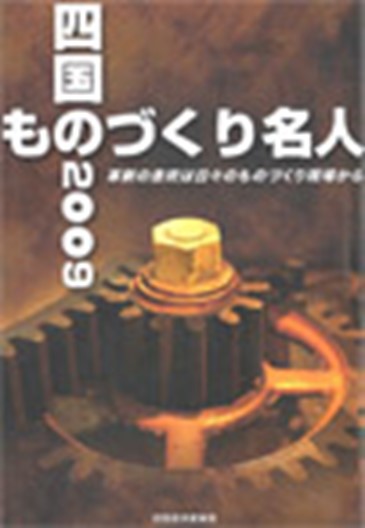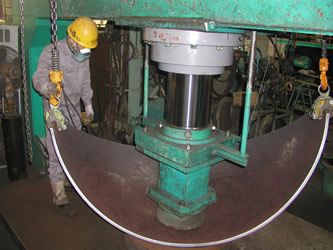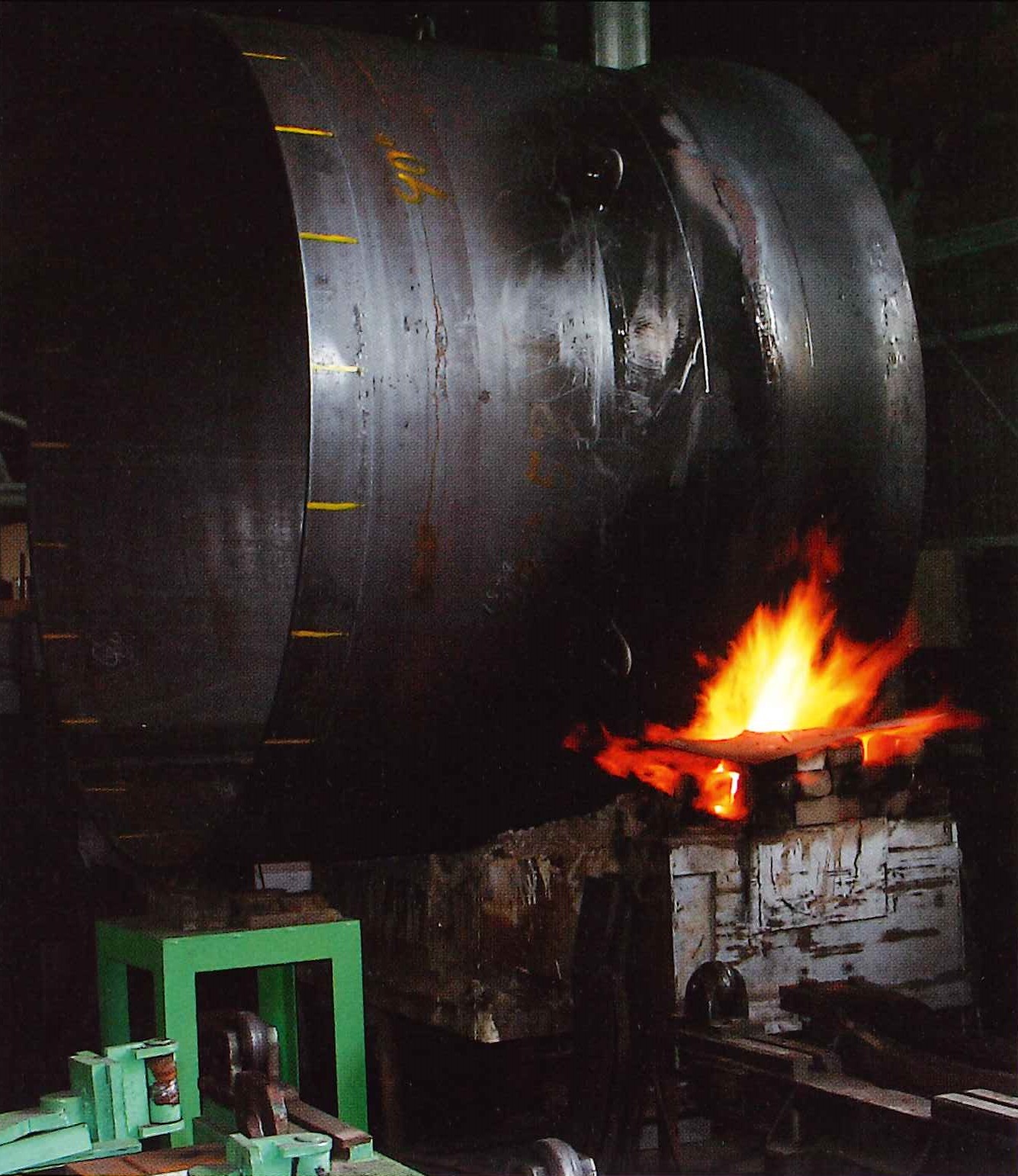
Article of Monodzukuri Master Craftsmanship in Shikoku 2009 award (compiled by the Shikoku Bureau of Economy, Trade and Industry)
TORTOISE ENGINEERING CO., LTD.
ŃĆĆIn April 1919, Tortoise Engineering Co., Ltd. started as Hada Iron Works in Ehime Prefecture. They have enhanced heat exchanger effectiveness and reduced the size of marine boilers, and have advanced their technologies steadily to produce multifunctional boilers and economizers. They have won their customersŌĆÖ trust with high safety, durability and economic performance of their marine boilers. They applied all these empirical knowhows to land use equipment, selling a variety of high-functional boilers including plant equipment with efficient opening and closing door called PITALOCK Door, as well as providing total services from planning, designing, producing, installation and test-running, and maintaining for various plant process equipment.
Segmental press bending works lower the cost of building marine boilers
ŃĆĆEvery marine boiler is different in size and type, and each one needs its own metallic mold according to their requirements, which is very costly. But segmental press bending works allows Tortoise Engineering to reduce the cost. Unlike conventional metallic molding, Tortoise Engineering produces hemispherical-shaped furnace by a cold press, and they spread the bottom of the flue boiler by a hot press. Their press bending work enables to produce the 22mm-steel plate component parts efficiently at a lower cost, while achieving a thickness decrease of 2mm or less.
ŃĆĆThis press bending work was revolutionary for small-and-mid-sized companies like Tortoise Engineering which deliver some 100 boilers a year.
ŃĆĆTheir boiler plates still keep their original name ŌĆ£Hada BoilerŌĆØ to remind them of their foundersŌĆÖ pride and spirit.
 Producing hemispherical-shaped furnace by a cold press bending
Producing hemispherical-shaped furnace by a cold press bending
Tortoise EngineeringŌĆÖs advanced segmental press bending techniques enables them to build boilers by themselves and reduce delivery waiting periods.
ŃĆĆIt was not practical for a small-and-mid-sized boiler maker to invest in every different type of mold.
ŃĆĆBut three of their adept mechanics press-bent, assembled and welded 5-segmental steel plates, finding the right bend-angles. Sometimes they bent too much, other times they did not bend enough. Those tireless empirical methods required a lot of costs. When forming mirror surfaces and crown plates, they had to heat the round steel end to bend R-bending. But as the temperature went down, the compressive stress caused a 20-30mm bump. They had to remove the bump to 0-1mm, which also took enormous time and energy.
ŃĆĆTo solve these forming challenges, they employed segmental press bending techniques. They could make, for example, hemispherical shaped furnace with less than 2mm wastage by segmental techniques, while in conventional forming process, the wastage was about 6mm when using 22mm-thick sheet plate. They developed their own techniques further by aligning the press positions, gaps, strengths, etc. to minimize the wastage through 2-segmental working, instead of 5-segmental one. That enabled them to reduce the forming time and cost substantially. They also altered the size and shape of the upper and lower press molds. With combination of three sets of these molds, they could make 1,000-2,420 ŽåmmŃĆĆhemispherical shaped furnaces.
ŃĆĆThey have solved various problems by figuring out ways; for the R bending of the mirror surface and crown plate, they insert the sheet plate right before the outer-slide roller; for removing the compressive deformation, and they push back to flat after applying the reverse bending.
 Spreading the bottom of the flue boiler by a hot press
Spreading the bottom of the flue boiler by a hot press
Applying the techniques of lower-cost marine boiler to land-use equipment
ŃĆĆTheir newly-crafted techniques led them to more efficient processing, a shorter delivery period, better use of the materials, saving more energy, and ultimately improved the working conditions for the employees.
ŃĆĆFor example, they successfully reduced wastage to 20 percent of sheet plate by 2-segmental press bending in the cold process from 50 percent by 5-segmental work when making deep-drawing hemispherical shaped furnace.
ŃĆĆThis type of equipment can be much smaller, compared with the big pressing machine with the mold, consuming less energy and making less noise. As this is not a high-speed press work, it disperses less dust. All these factors contribute greatly to improve the working environment.
ŃĆĆIt is common that boiler makers order the hemispherical shaped furnace, mirror surface and crown plate to different specialists, and they do their own plate work and welding by themselves. However, transporting components and having the authorities to be tested took time. It was a tall order for many boiler makers to reduce the time, process and cost.
ŃĆĆSegmental press bending solved all these problems at a single stroke. As Tortoise Engineering now is an approved plant, they can undertake all the necessary works including lengthy regular pressure-proof tests at their own factory, and reduced the delivery period by 7-14 days. As a result, they lowered shipping losses and processing wastage.
TortoiseŌĆÖs boiler has been working for 80 years, which proves their top-notch skills.
ŃĆĆŌĆ£It is common for building four or five ships out of a blueprint, and winning the installation of the boiler for the first ship is extremely important,ŌĆØ says one of the Tortoise EngineeringŌĆÖs sales reps. All their staffs have their passports, and are always ready to travel wherever their boiler is on the globe for the maintenance, which can then lure the subsequent orders.
ŃĆĆUntil 2021, Tortoise Engineering have made 4,100 marine boilers in total.
ŃĆĆThe Japan Boiler Association found that the longest working boiler in Japan was the one Tortoise Engineering made for a candle factory in Nagahama (?zu City, Ehime Prefecture) 80 years ago, which is still working. This can prove the durability and superiority in their boiler-making process.
